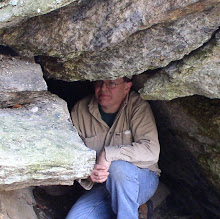There's a little piece of Heaven that exists, just south of the Vermont border, in the Town of Colrain. The Catamount Hill(s) were first settled around 1780, mostly abandoned a century later. Geologically, much of this area is underlain by the Waits River and Goshen Formation, parts of which were formerly called the Conway Schists during the late 1800s by eminent geologist B.K. Emerson.
As far as the interests of the amateur speleologist and geologist might go, there is the presence of marble/limestones to be found in these old Conway Schists. And even furthermore, one of three 'major' caves in the Catamount Hills may have been formed within those marbles. But on this particular day, conditions meant hiking in a ways to my first objective: the Bear's Den.
The old roads are often flooded due to poor drainage and beaver activities. The Bear's Den is a major rupture in the ledgy hillside that has formed a separation - and cave - of good size. At just over 50 feet, this is a good size cave for these parts! Enjoying my first visit to this area since 2006, I eventually moved along to the area of the Catamount Dens and the Oven. Along the way, occasional outcrops of the grainy black marble could be found. Even popping up in the middle of the roadbed.
My long-ago past visit to the Oven did determine a small presence of marble, thus providing evidence of a traditional solutional genesis. However, I had a nagging feeling over the years that I'd like to see more than that. Between photography and running several dozen tests on the surrounding bedrock, this ate up the lion's share of my time this day. But it was worth it! A much greater presence of marble was to be discovered, furthering the evidence of this cave being a rare formation in Massachusetts, outside of the Berkshires!
Packing up, I moved a short distance 'down around the corner' to the Catamount Den(s), proper. This very impressive collapsed ledge, sports a good size talus cave. It also appears to be at the head of a major drainage that probably dates to around the end of the last ice age. This drainage was eventually followed down to McLeod Pond. Of interest here, were some significant outcrops of marble. These seem to extend out into the water but I'd need water access to confirm that.
It only remained (yeah - right) to climb out of the area surrounding the pond to access my route back to the car. This proved more difficult than anticipated and I eventually arrived ending a VERY long - but enjoyable and productive - day in the outdoors. Then the long drive home.
Methodism in the Hills "Another sect appeared in this area when the Troy Conference sent missionaries to Rowe in 1800. There they succeeded in forming a class of a dozen members that became one of the circuit which included Catamount Hill. The Methodists did not believe that buildings were necessary for their purposes. Meetings were held in groves, caves and barns. The Hill meetings were held at the Oven Den and in the newly erected unhewn log school house. Twenty years later the Methodist Reform Church of Colrain was organized by the leading men on the Hill. One of the preachers was Doctor Pardon Hayes of Rowe."




